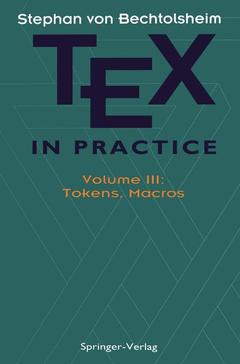Description
TEX in Practice, 1993
Volume III: Tokens, Macros
Monographs in Visual Communication Series
Author: Bechtolsheim Stephan v.
Language: EnglishApproximative price 105.49 €
Subject to availability at the publisher.
Add to cart
656 p.
· 15.5x23.5 cm
· Paperback
Description
/li>Contents
/li>
TEX has always been regarded as the most elegant and powerful system for computer typesetting. However, its widespread use beyond academia was hampered by its complexity. Recently, fairly good TEX implementations have come out for PC's putting TEX on the disks of many people including writers, designers, desktop publishers, and engineers. Consequently, interest in TEX has surged. What is needed at this point is a book that teaches step-by-step how to use TEX, illustrating each step with relevant examples. This is exactly what S. v. Bechtolsheim's book does. It is a tutorial and guide for the first-time user of TEX, as well as a reference for the more experienced "TEXpert." TEX in Practice will appear as a four volume set, starting with TEX in Practice, Volume 1: Basics; TEX in Practice, Volume 2: Paragraphs, Math and Fonts; TEX in Practice, Volume 3: Tokens, Macros; TEX in Practice, Volume 4: Output Routines, Tables. TEX in Practice will be an indispensable reference for the TEX community and a guide through the first step for the TEX novice.
18 Tokens, Category Codes, Verbatim Modes.- 18.1 Tokens.- 18.2 Active Characters.- 18.3 Verbatim Modes.- 18.4 Uppercase and Lowercase Characters, \uccode, \lccode, \uppercase, etc.- 18.5 Summary.- 19 More on Tokens.- 19.1 Converting Character Strings to Tokens, and Tokens Back to Character Strings.- 19.2 Array Macros.- 19.3 Cross-Referencing Using \csname...\endcsname.- 19.4 Curly Braces.- 19.5 Summary.- 20 Token Registers, TfeX List Processing.- 20.1 Token Registers.- 20.2 TEX Lists.- 20.3 Using TfeK Lists for the Emulation of Arrays.- 20.4 Summary.- 21 Macros.- 21.1 Assigning a Meaning to a Control Sequence.- 21.2 Primitive Control Sequences.- 21.3 Macros.- 21.4 Some Simple Macro Examples.- 21.5 The Theory of Macro Definitions.- 21.6 Macro Definitions Using \outer.- 21.7 Macros with Parameters.- 21.8 Macros with Undelimited Parameters.- 21.9 Macros with Delimited Parameters.- 21.10 Mixed Parameter Types.- 21.11 Spaces after Macro Calls, \ignorespaces.- 21.12 Summary.- 22 Macros, Expansion Issues.- 22.1 Expanded Macro Definitions, \edef.- 22.2 Macro Expansion.- 22.3 Placement of Macro Calls and Arguments.- 22.4 Category Codes and Parameters.- 22.5 Nested Macro Definitions.- 22.6.Defining “\long”Macros.- 22.7.Organizing Your Own Macros.- 22.8 Keyword Parameters.- 22.9 Summary.- 23 More on Macro-Related Items.- 23.1 \afterassignment.- 23.2 \Let: Making Control Sequences Equivalent.- 23.3. \let and Undefined Tokens.- 23.4 Looking Ahead with \futurelet.- 23.5 Summary.- Advanced Macro Concepts.- 24.1 Changing the Order of Expansion, \expandafetr.- 24.2 Suppressing Expansion with \noexpand.- 24.3 The Almighty \the.- 24.4 When No Exoansion Takes Place.- 24.5 Summary.- Conditional and Their Applications.- 25.1 Conditionals.- 25.2 Conforming Conditionals.- 25.3 Summary.-Date and Calendar Macros.- 26.1 The Earliest Date Accommodated by the Presented Macros.- 26.2 Copying Date, \CopyDate.- 26.3 Codes for the Days of a Week.- 26.4 Print a Month, \ProvideMonth.- 26.5 Check for the Legality of a Year: \CheckLegalYear.- 26.6 Check for the Legality of Month: \CheckLegalMonth.- 26.7 Compute the Number of Days in a Month, \NumberOfDaysInMonth.- 26.8 Check for the Validity of a Date.- 26.9 Is a Year a Leap Year?.- 26.10 Compute the Number of Days in Year.- 26.11 Compute the Date of the Following Day.- 26.12 Compute the Date of the Previous Day.- 26.13 Compute the Same Day of the Week in the Next or Previous Week.- 26.14 Compute the Next Month.- 26.15 Compute the Previous Month.- 26.16 Compute the Day of the Week of an Arbitrary Date.- 26.17 Printing Today’s Date.- 26.18 Compute The Monday of the Same Week of Some Given Date.- 26.19 Small Monthly Calendars.- 26.20 Printing a Group of Three Monthly Calendars.- 26.21 A Yearly Calendar Macro.- 26.22 Compute the Week Number of a Date Within a Year.- 26.23 Loading All Date-Related Macros.- 26.24 Summary.- Recursion, Loop Constructs, Modes, testing of TEX Code and Related Items.- 27.1 Recursive Macros and Loops in TEX.- 27.2. Enumeration Macro Definitions.- 27.3. Box Register Queue Macros.- 27.4 \relax.- 27.5 \jobname.- 27.6 \Environments.- 27.7 Modes.- 27.8 LATEX and the Plain Format.- 27.9 Debugging TEX MAcros and TEX Code in General.- 27.10 User Macro Error Messages, \errmessage, \errhelp.- 27.11 The Definition of Macro \tracingall.- 27.12 Writing to the Log File and the Terminal, \pausing.- 27.13 Summary.- Reading From and Writing To Files.- 28.1 File Names in TEX.- 28.2 Reading from a File on a Line-By-Line Basis.- 28.3 Reading-In a Complete File, \input.- 28.4 More \input Related MAcros.- 28.5Writing to a File.- 28.6 Summary.- More on Input and Output.- 29.1 Index File Writing.- 29.2 Writing Table of Contents Files.- 29.3 Verbatim Writing to Files.- 29.4 Macros to Write Endnotes.- 29.5 Writing to the Log File and the Terminal.- 29.6 Protocol File Writing.- 29.7 Comparing Two Files.- 29.8 \shipout, \tracingoutput, \deadcycles, \maxdeadcycles.- 29.9 \special.- 29.10 Summary.- Partial Processing of a Document.- 30.1 A General Overview of the Macros of this Chapter.- 30.2 Main Document and Part Source Files, Auxiliary Files.- 30.3 Macros for the Partial Processing of a Document.- 30.4 Administrative Files.- 30.5 The Generation of a Table of Contents.- 30.6 Putting the Pieces Together.- 30.7 Macros Source Files.- 30.8 Cross-Referencing Macros for Partial Processing Macros.- 30.9 Summary.- More on the Partial Processing of a Documents.- 31.1 An Example Application.- 31.2 The Partial Processing Macros Used to Typeset This Series.- 31.3 The TEXIP Format.- 31.4 Summary.
© 2024 LAVOISIER S.A.S.


